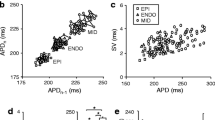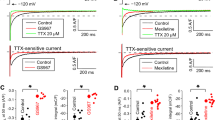Summary
Electrophysiological effects of bisaramil, a novel antiarrhythmic agent, were examined using the conventional microelectrode technique applied to cardiac multicellular preparations from guinea-pigs, rabbits and dogs and the whole-cell patch-clamp technique applied to guinea-pig ventricular myocytes. Bisaramil at 10−6 M or higher concentrations produced a dose-dependent decrease in the maximum rate of rise (\(\dot V\) max) of action potentials of guinea-pig papillary muscles without changes in resting membrane potentials. In the presence of bisaramil, trains of stimuli at rates > 0.1 Hz led to the use-dependent block of \(\dot V\) max, which was enhanced at higher frequencies. At a concentration of 3 × 10−6 M, the degree of use-dependent block was about 35% at 3.3 Hz, of which degree was comparable to those of 10−4 M disopyramide and lidocaine. The development of \(\dot V\) max block by bisaramil was expressed by a single exponential function in the same manner as flecainide, whereas the time courses of the block development by disopyramide and lidocaine were described by two exponentials. Recovery time constants from Vmax block were 44.1±3.4 s and 20.3±2.3 s for bisaramil and flecainide, respectively. Bisaramil at 10−6 and 3 × 10−6 M did not change the action potential duration of guinea-pig papillary muscles and rabbit atrial muscles with a significant reduction of \(\dot V\) max. No change in action potential duration can be explained by depression of both the Ca2+ and the delayed outward K+ currents by bisaramil. On the other hand, 10−6 M bisaramil shortened action potential duration of canine Purkinje fibers at 50% and 90% of repolarization. In addition, bisaramil (3 × 10−6 M) suppressed sinus node automaticity, which agreed with voltage clamp studies indicating that bisaramil directly suppressed the calcium channel. These results suggest that bisaramil may be classified as class Ic agent showing a slow kinetic and potent action on the sodium channel.
Similar content being viewed by others
References
Borchard U, Boisten M (1982) Effect of flecainide on action potentials and alternating current-induced arrhythmias in mammalian myocardium. J Cardiovasc Pharmacol 4:205–212
Campbell TJ (1983a) Kinetics of onset of rate-dependent effects of class I antiarrhythmic drugs are important in determining their effects on refractoriness in guinea-pig ventricle, and provide a theoretical basis for their subclassification. Cardiovasc Res 17:344–352
Campbell TJ (1983b) Importance of physico-chemical properties in determining the kinetics of the effects of class I antiarrhythmic drugs on maximum rate of depolarization in guinea-pig ventricle. Br J Pharmacol 80:33–40
Carmeliet E, Saikawa T (1982) Shortening of the action potential and reduction of pacemaker activity by lidocaine, quinidine, and procainamide in sheep cardiac Purkinje fibers. An effect on Na or K current? Circ Res 50:257–272
Clarkson CW, Follmer CH, Ten Eick RE, Hondeghem LM, Yeh JZ (1988) Evidence for two components of sodium channel block by lidocaine in isolated cardiac myocytes. Circ Res 63:869–878
Coraboeuf E, Deroubaix E, Coulombe A (1979) Effect of tetrodotoxin on action potentials of the conducting system in the dog heart. Am J Physiol 236:H561-H567
Courtney KR (1980) Interval-dependent effects of small antiarrhythmic drugs on excitability of guinea-pig myocardium. J Mol Cell Cardiol 12:1273–1286
Hamill OP, Marty A, Neher E, Sakmann B, Sigworth FJ (1981) Improved patch-clamp techniques for high resolution current recording from cells and cell-free membrane patches. Pflügers Arch 391:85–100
Haruno A, Matsuzaki T, Hashimoto K (1989) Antiarrhythmic effects of YUTAC on canine ventricular arrhythmias. J Mol Cell Cardiol 21: [Suppl 11] 12
Hille B (1977) Local anesthetics: Hydrophilic and hydrophobic pathways for the drug-receptor reaction. J Gen Physic 69:497–515
Hirano Y, Hiraoka M (1988) Barium-induced automatic activity in isolated ventricular myocytes from guinea-pig hearts. J Physiol (Lond) 395:455–472
Hiraoka M, Okamoto Y, Sano T (1981) Oscillatory afterpotentials in dog ventricular muscle fibers. Circ Res 48:510–518
Hiraoka M, Kuga K, Kawano S, Sunami A, Fan Z (1989a) New observations on the mechanisms of antiarrhythmic actions of disopyramide on cardiac membranes. Am J Cardiol 64:15J–19J
Hiraoka M, Sunami A, Fan Z (1989b) Reassessment of the kinetics of the \(\dot V\) max block of action potentials by class I antiarrhythmic agents in guinea pig papillary muscles. In: Toyama J, Hondeghem LM (eds) Current topics in antiarrhythmic agents. Excerpta Medica, Amsterdam, pp 73–80
Hondeghem LM, Katzung BG (1977) Time- and voltage-dependent interactions of antiarrhythmic drugs with cardiac sodium channels. Biochim Biophys Acta 472:373–398
Hondeghem LM, Katzung BG (1984) Antiarrhythmic agents: The modulated receptor mechanism of action of sodium and calcium channel-blocking drugs. Ann Rev Pharmacol Toxicol 24:387–423
Kinnaird AAA, Lederman CL, Man RYK (1985) Electrophysiological actions of flecainide in normal and infarcted canine Purkinje fibers. Eur J Pharmacol 112:57–64
Nelder JA, Mead R (1965) A simplex method for function minimization. Comput J 7:308–313
Paróczai M, Kárpáti E, Solti F (1990) The effects of bisaramil on experimental arrhythmias. Pharmacol Res 22:463–480
Sada H, Ban T (1981) Effects of various structurally related beta-adrenoceptor blocking agents on maximum upstroke velocity of action potential in guinea-pig papillary muscles. Naunyn-Schmiedeberg's Arch Pharmacol 317:245–251
Sheets MF, Hauck DA, Fozzard HA (1988) Nonlinear relation between \(\dot V\) max and INa in canine cardiac Purkinje cells. Circ Res 63:386–398
Starmer CF, Grant AO, Strauss HC (1984) Mechanisms of use-dependent block of sodium channels in excitable membranes by local anesthetics. Biophys J 46:15–27
Sunami A, Fan Z, Nitta J, Hiraoka M (1991) Two components of use-dependent block of Na+ current by disopyramide and lidocaine in guinea pig ventricular myocytes. Circ Res 68:653–661
Vaughan Williams EM (1970) Classification of anti-arrhythmic drugs. In: Sandoe E, Flensted-Jansen E, Olesen KH (eds) Symposium on cardiac arrhythmias. AB Astra, Sodertalje, Sweden, pp 449–472
Vaughan Williams EM (1984) A classification of antiarrhythmic actions reassessed after a decade of new drugs. J Clin Pharmacol 24:129–147
Author information
Authors and Affiliations
Additional information
Send offprint requests to M. Hiraoka at the above address
Rights and permissions
About this article
Cite this article
Sunami, A., Sawanobori, T., Adaniya, H. et al. Electrophysiological properties of a new antiarrhythmic agent, bisaramil on guinea-pig, rabbit and canine cardiac preparations. Naunyn-Schmiedeberg's Arch Pharmacol 344, 323–330 (1991). https://doi.org/10.1007/BF00183007
Received:
Accepted:
Issue Date:
DOI: https://doi.org/10.1007/BF00183007




